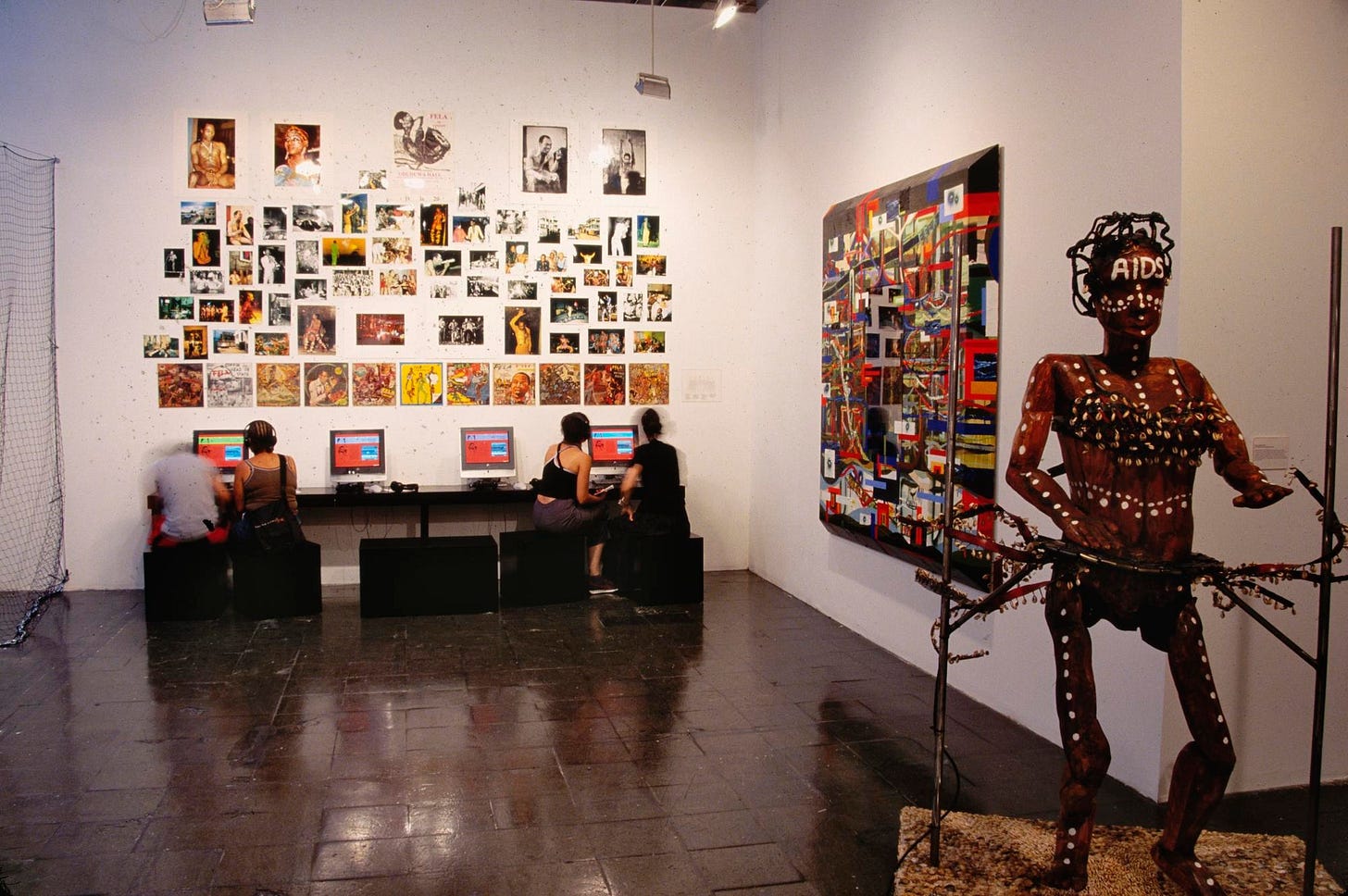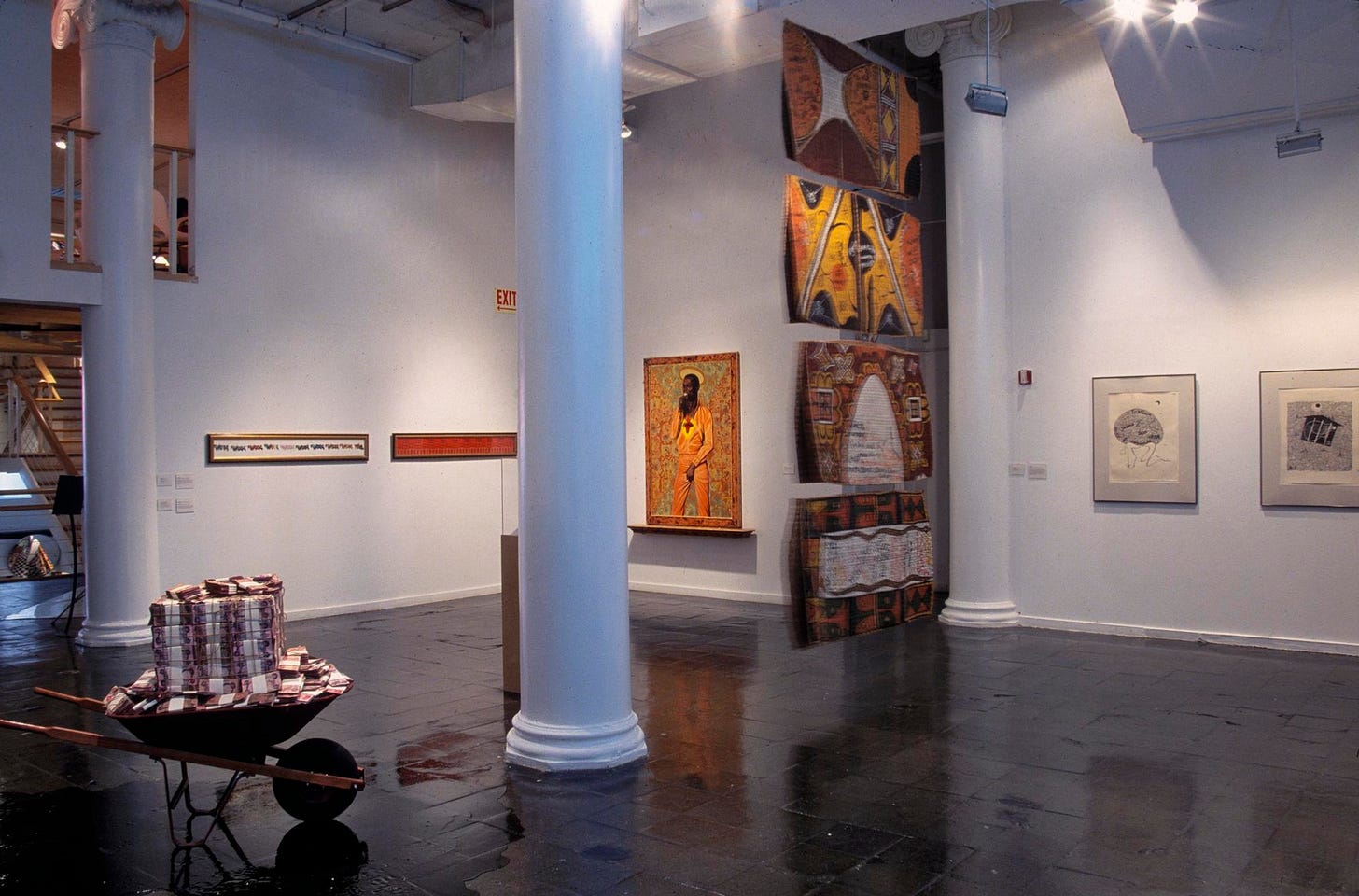20 Years After: The Music of ‘Black President’
Personal History + Download: In 2003, Trevor Schoonmaker and I curated music accompanying The New Museum's art exhibit about Fela Kuti. That experience reverberates in many ways.
July 2003 marked an initial crux in how I approached my work with music, who I was inside that work, even beginning to reimagine what that work could be. By then, I’d been a mildly successful freelance writer, but with better ideas than bylines and lacking follow-through. Though in the process of turning a corner, thanks to a few editors at the Village Voice, and a great therapist. I was finally considering what it was I had to say about music and life — especially about dance music, its role as a social and cultural force, its power to shape all participants, and to cross civic, national and artistic borders. I was, for the first time, thinking of myself less as American-in-waiting, which in the post-9/11 world finally became synonymous with negligence, than as the immigrant I’d always been — yet after many years of faking it (from my name to the Dream), seemed not at all.
Working with the curator Trevor Schoonmaker on what would become the New Museum exhibit, “Black President: The Art and Legacy of Fela Anikulapo Kuti” was a matter of kinship, perseverance, foresight and development of that vision. Trevor and I embraced the challenge of honoring the subject (who was, at the time, still under-acknowledged in America), of bringing together art and music in a way that hadn’t previously been done in a museum, and of trying to contextualize an African artist’s work through both an American audience’s lens and a global historical one.
Trevor had been formally at it for a while already. Introduced a few years earlier by a mutual friend who did so because, as she put it, we both constantly talked about “soccer and Fela,” he and I bonded pretty quickly. Having lived in West Africa and studied African contemporary art, Schoonmaker already had in mind the contours of what he was calling The Fela Project — though Fela being a musician, Trevor’s initial idea was the creation of a music festival to honor the Afrobeat legend who’d passed away from AIDS on August 2nd 1997. The Project was launched in 2001, on the anniversary of Fela’s death, as a party called “Jump N Funk,” with Rich Medina spinning Afrobeat-heavy house music at a club on West Broadway and Canal. Schoonmaker was a reluctant co-promoter, but the party almost instantly became a magnet for an incredible community of people, especially African and Black American visual artists. This naturally pivoted the Project away from “festival” and more towards “art exhibit.”
Throughout, I was the music-writer-guy/hanger-on, helping however I could, which, by the time Trevor sold the New Museum hierarchy on the idea of a group exhibit about this revolutionary Nigerian musician, was by helping curate the accompanying music program. (A download of the program is available below, if you wanna skip ahead.) Even back in 2002-03, the word “curator” scared the hell out of me. But Trevor, who remains a friend and occasional colleague, cooled me down. He encouraged rigor coupled with a specific, personal point-of-view, more so than a version of completism, or a set of “perfect choices” which do not exist — and which only formulate a stunted canon. Excellence in choice, I came to regard, is better understood as “versions” (Jamaican dub definition) or variations. Finality lies only in completion. Curation — like “taste,” I now believe — is a matter of knowledge, back-story and strong perspective. Without those, it was only opinion and “bullshit” (to use one of Fela’s favorite words). This was one of my great lessons in this experience.
So that’s how the music of “Black President” came together. Reading and conversing, archive- and crate-digging. Accessing my own encounters with Fela, my ongoing expansive love for African music, and then of chasing these sounds and stories at record stores, in libraries and on the shelves of friends and colleagues. Reading timely articles and books. (Big big-ups Michael Veal and Jay Babcock.) Emailing elders and smarties with whom I’d talk about their lives on the continent (Thank you forever Randy Weston), or their love of Afrobeat (Thank you big Phil Ballman, who in the process pointed me towards Ishmael Reed’s “Mumbo Jumbo,” which itself fired up cultural neurons). If I have any regrets towards that time, it’s that I should have gone to London much sooner, and spent less time listening to critics who had big jobs, bigger egos and little to add.

My contribution ended up as what we’d now call a “playlist,” which took the form of a musical timeline. It began with sounds that predated and informed the development of highlife, and, more importantly, of Fela’s Afrobeat; followed through some high-points of Fela’s own Afrika 70/Egypt 80 catalog, alongside the influence of West African culture on global music in the 1970s and ‘80s; continued towards Fela’s ascendancy as a globally-acknowledged pan-African voice informing the music of his era; and then finally, into the long-tail of Fela/Afrobeat’s legacy within the global Black rhythm cultures that ensued. All with covers, samples and referential songs thrown in. “[Fela’s] art became a dominant vehicle for the espousal of social, political and philosophical tenets,” writes Dele Jegede, a Nigerian painter, academic and critic in “Dis Fela Self!,” part of the 2003 book of essays Trevor edited called, “Fela: From West Africa to West Broadway.” And that’s what the “Black President” music program tried to reflect. It was a mixtape — which remains a useful metaphor for most of my work — of ideas and sounds of the time(s), with Fela indisputably at its center.
Of course this mixtape had to have some intellectual heft because it was in a museum, an institution I placed in high esteem since basically living at the Hermitage during my childhood in Leningrad. But some of the circumstances around “Black President'' also made it seem less weighty at the time. Maybe it was the period of change in my own life, when critiquing America’s institutionalism was crystallizing as a permanent part of my character. Or maybe it was the nature of the subject: a musician whose story was, at the time, not museum-friendly, and which resonated with my own, and with my evolving worldview. Or maybe it was the comfort of working side-by-side with a friend who didn’t seem intimidated by the circumstances. There was definitely the feeling that much of the work which was going to surround my little music station, was as out of place with the art/museum establishment as I was.
Two decades hindsight, “Black President” can be regarded as a landmark, convening a global community of artists of color, whose materials and ideas redefined the purpose and meaning of “fine” and “contemporary” art. Before the installation walk-through, my nervousness was based on living up to institutional biases; afterwards, it was having my so-called “curation” live next to what was obviously life-blessing work. Some of it was familiar, like Ghariokwu Lemi’s record covers and David Corio’s photos. Some of it was by artists with names I already knew well —Fred Wilson, Kara Walker, Alfredo Jaar. But it was artists then-unfamiliar to me, some of whom I got to know a bit (and even work with) in the wake of “Black President,” some of whom have become superstars and legends — folks like Barkley Hendricks, Wangechi Mutu, Sanford Biggers, Yinka Shonibare, Odili Donald Odita and Radcliffe Bailey — that gave the exhibit its aura. There was an incredible newness and freshness to the work, and yet it felt timeless, serving much older gods than art-capital’s filthy lucre, or institutional expectation. In retrospect, to have a hand in something that momentous feels like my own blessing. To have folks commend my work for how it fit next to theirs, still feels like a dream.
“The Black President: The Art & Legacy of Fela Anikulapo-Kuti” opened at the New Museum on July 11th 2003. In the Spring of 2004 it traveled to the Yerba Buena Center for the Arts in San Francisco, that Fall to the Barbican in London (accompanied by a weekend of “Red Hot + Riot” concerts), and then to Cincinnati’s Contemporary Arts Center, where it closed in March of 2005.
Recently, I saw Trevor and one of the artists in the show. Both asked if I could share with them the music program, which they never had copies of. (The potential licensing nightmare kept the program as an in-exhibit-only experience.) I of course still had the original CD-Rs onto which we compiled and burned the recordings, so I digitized the music for them. And I figured other folks might be interested as well. So I’ve made the DropBox file public.
DOWNLOAD ZIP FILE: "Black President - The Art & Legacy of Fela Anikulapo Kuti" music program compiled and curated by Piotr Orlov & Trevor Schoonmaker
Before folks ask, no I have not made a streaming playlist. If that is your thing, I encourage you to do so, and make it public. My guess is that, at this point, most of the program’s songs are available widely. There are a few conversations ongoing about doing an update or a contemporary variation of the program. In the years since “Black President,” Fela became a much more widely praised and admired cultural figure, regularly referenced between Bob Marley and Che. Meanwhile, Afrobeat’s expansion and mutation into drum-machine powered dance music and as a cornerstone sound of London’s multi-generational improvisational music scene, has continued apace. Major props for the latter development need to be handed to the late Tony Allen, the Afrika 70 drummer who passed away in 2020, but not before adding his great beat to some wonderful, far-flung records (even from beyond the grave).
Please enjoy the music. Thank you Trevor Schoonmaker for the opportunity, and thank you Fela Anikulapo-Kuti for the work.







Very enlightening. I didn’t know this about your past!